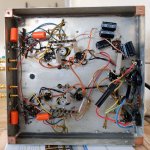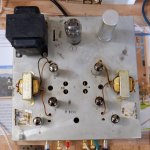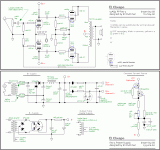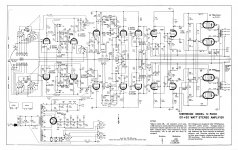I've got a Zenith 7b31 amp from a console. Was recapped when pulled (not by me). Tried different set of power tubes and different driver tubes, though haven't tried a new rectifier tube.
Sounds good, but the volume seems low (lower than a similar console pull el84 amp I tried). Slight hum is coming off the amp, from the chassis not the speakers. Out of speakers is dead quite with no hum or buzz (if no source plugged in a slight hum that goes away with source plugged in, so maybe a ground issue?)
I've got a schematic and a volt meter. Is there something I should be looking for that could cause low volume.
Sounds good, but the volume seems low (lower than a similar console pull el84 amp I tried). Slight hum is coming off the amp, from the chassis not the speakers. Out of speakers is dead quite with no hum or buzz (if no source plugged in a slight hum that goes away with source plugged in, so maybe a ground issue?)
I've got a schematic and a volt meter. Is there something I should be looking for that could cause low volume.
Missing tuner preamp? Post the schematic.
Yep. It is just the power amp without the tuner/preamp.
The link below is a google docs share link. Not sure if that is kosher on the forum (file is too big to upload).
https://drive.google.com/file/d/0By97rOiMvv9iNEF2SEhRNWlYeE0/view?usp=sharing
After double checking the bias (setting each set to zero per the schematic), I tried the amp in some more configurations.
Put a little line level amp in between the preamp and amp. With that in place I can get the amp to clip, though it only goes a tiny bit louder before clipping.
Also tried another source and connected it to some more efficient speakers. Still doesn't hit moderate listening levels without clipping. Sound is pleasant in all configurations, but seems a little anemic.
If it just a gain issue, I wouldn't worry too much, but I'm afraid there might be some kind of problem with how things were hooked up when the preamp was pulled.
Put a little line level amp in between the preamp and amp. With that in place I can get the amp to clip, though it only goes a tiny bit louder before clipping.
Also tried another source and connected it to some more efficient speakers. Still doesn't hit moderate listening levels without clipping. Sound is pleasant in all configurations, but seems a little anemic.
If it just a gain issue, I wouldn't worry too much, but I'm afraid there might be some kind of problem with how things were hooked up when the preamp was pulled.
For starters, the NFB loop comes through that power connector. The speaker drivers connect to different taps on the O/P trafo. and only a cap. is used for a crossover.
The O/P transformers are a mixed bag. Their size is unimpressive, as is to be expected in a console amp. However, they do contain a tertiary NFB winding.
Things are not awe inspiring. However, you have a decent power trafo, as the photo shows some heft and a 5U4 yields up to 250 mA. of B+. Believe me, the OEM would have used a lesser part, if they could have gotten away with it. The chassis is roomy, which allows for all sorts of modifications/enhancements.
How much power is needed by your most sensitive speaker pair? I'm scheming/plotting a variation on the "El Cheapo" setup I've uploaded.
The O/P transformers are a mixed bag. Their size is unimpressive, as is to be expected in a console amp. However, they do contain a tertiary NFB winding.

Things are not awe inspiring. However, you have a decent power trafo, as the photo shows some heft and a 5U4 yields up to 250 mA. of B+. Believe me, the OEM would have used a lesser part, if they could have gotten away with it. The chassis is roomy, which allows for all sorts of modifications/enhancements.
How much power is needed by your most sensitive speaker pair? I'm scheming/plotting a variation on the "El Cheapo" setup I've uploaded.
Attachments
How much power is needed by your most sensitive speaker pair? I'm scheming/plotting a variation on the "El Cheapo" setup I've uploaded.
We pared down before a resent move, so I'm using bookshelf speakers rated at 88dB. I've been thinking about getting a kit and making up something else, but to keep my wife happy, I'll bet I won't go very big so probably wont get much above 89-91dB.
I'm a little daunted by the prospect of gutting it and starting over, but as you say, it is really roomy under there which should make it doable.
If you have the inclination it would be better to rebuild it according to some schematic like Eli's. But if you want to try and repair or revive your amp it looks like it needs a gain stage before the 12au7s. That would be somewhat easier in that you only need a 12ax7. That would involve installing the socket for the tube and associated wiring and probably a B+ supply. From the schematic it looks like the 12ax7 in the radio/preamp section drove the 12au7s. I am not positive if you could just take the 12ax7 circuit from the schematic since there is a tone control around it. Tone controls sometimes reduce the gain to the next section.
But, Eli's idea is more of a sure thing since his schematic is built as a stand alone stereo amp. Good luck!
But, Eli's idea is more of a sure thing since his schematic is built as a stand alone stereo amp. Good luck!
Let's apply Paul Joppa's 102 dB. rule to those 88 dB. sensitive speakers. Joppa's Rule states that for "typical" listening spaces an amp/speaker combo should be capable of 102 dB. SPL pulses at a 1 M. distance. The rule indicates you need upwards of 30 WPC. We can't get that out the power trafo on hand, but approx. 20 WPC, which should suffice (most of the time), is not out of the question. We'll "borrow" the power section of the excellent Sherwood 5000 integrated amp (schematic uploaded).
In order to get a "tall" enough B+ rail, SS rectification will be employed.
The only current production O/P tube to use is the Russian 6П14П-EV (6p14p-ev), AKA EL84M, that is a true, very tough, 7189 equivalent, with good sonics.
The 7199 has gone the way of the dodo. Hunt down 2X decent 6BL8s, which will be fine. Scott used the 6BL8, 'nuf said.
The power trafo has a extra filament winding for the tuner preamp wired to the connector. Phase that winding up with the 1 used by the power amp. Both windings, connected in parallel, will ensure plenty of heater power is present.
Obviously, the puny OEM O/P "iron" has to go. The "budget" choice I've come up with is Edcor's CXPP30-MS-10K. The 30 W. rating of that "iron" is marginal, considering the GNFB loop present. We'll deal with that by limiting the LF limit of this setup slightly below 30 Hz. Given the bookshelf speakers, that should be a non-issue. BTW, the lowest note a "standard" double bass plays is 41 Hz.
We definitely have a bias (C-) supply to work out. Also, because of the 10 Kohm primary in the CXPP30-MS-10K, boosting the B+ rail voltage upwards could be necessary. Both of those issues are easy enough to deal with.
In order to get a "tall" enough B+ rail, SS rectification will be employed.
The only current production O/P tube to use is the Russian 6П14П-EV (6p14p-ev), AKA EL84M, that is a true, very tough, 7189 equivalent, with good sonics.
The 7199 has gone the way of the dodo. Hunt down 2X decent 6BL8s, which will be fine. Scott used the 6BL8, 'nuf said.
The power trafo has a extra filament winding for the tuner preamp wired to the connector. Phase that winding up with the 1 used by the power amp. Both windings, connected in parallel, will ensure plenty of heater power is present.
Obviously, the puny OEM O/P "iron" has to go. The "budget" choice I've come up with is Edcor's CXPP30-MS-10K. The 30 W. rating of that "iron" is marginal, considering the GNFB loop present. We'll deal with that by limiting the LF limit of this setup slightly below 30 Hz. Given the bookshelf speakers, that should be a non-issue. BTW, the lowest note a "standard" double bass plays is 41 Hz.
We definitely have a bias (C-) supply to work out. Also, because of the 10 Kohm primary in the CXPP30-MS-10K, boosting the B+ rail voltage upwards could be necessary. Both of those issues are easy enough to deal with.
Attachments
I've got a Zenith 7b31 amp from a console. Was recapped when pulled (not by me). Tried different set of power tubes and different driver tubes, though haven't tried a new rectifier tube.
Sounds good, but the volume seems low (lower than a similar console pull el84 amp I tried). Slight hum is coming off the amp, from the chassis not the speakers. Out of speakers is dead quite with no hum or buzz (if no source plugged in a slight hum that goes away with source plugged in, so maybe a ground issue?)
I've got a schematic and a volt meter. Is there something I should be looking for that could cause low volume.
Zach
What are you using for a source to drive the amp? That may not be pushing enough signal to drive it to full power.
Zach
What are you using for a source to drive the amp? That may not be pushing enough signal to drive it to full power.
I've been using the preout from a Denon receiver, but I also put a line stage booster to up the input. Helped a little, but started clipping at a lower volume than I'd like.
Let's apply Paul Joppa's 102 dB. rule to those 88 dB. sensitive speakers. Joppa's Rule states that for "typical" listening spaces an amp/speaker combo should be capable of 102 dB. SPL pulses at a 1 M. distance. The rule indicates you need upwards of 30 WPC. We can't get that out the power trafo on hand, but approx. 20 WPC, which should suffice (most of the time), is not out of the question. We'll "borrow" the power section of the excellent Sherwood 5000 integrated amp (schematic uploaded).
In order to get a "tall" enough B+ rail, SS rectification will be employed.
The only current production O/P tube to use is the Russian 6П14П-EV (6p14p-ev), AKA EL84M, that is a true, very tough, 7189 equivalent, with good sonics.
The 7199 has gone the way of the dodo. Hunt down 2X decent 6BL8s, which will be fine. Scott used the 6BL8, 'nuf said.
The power trafo has a extra filament winding for the tuner preamp wired to the connector. Phase that winding up with the 1 used by the power amp. Both windings, connected in parallel, will ensure plenty of heater power is present.
Obviously, the puny OEM O/P "iron" has to go. The "budget" choice I've come up with is Edcor's CXPP30-MS-10K. The 30 W. rating of that "iron" is marginal, considering the GNFB loop present. We'll deal with that by limiting the LF limit of this setup slightly below 30 Hz. Given the bookshelf speakers, that should be a non-issue. BTW, the lowest note a "standard" double bass plays is 41 Hz.
We definitely have a bias (C-) supply to work out. Also, because of the 10 Kohm primary in the CXPP30-MS-10K, boosting the B+ rail voltage upwards could be necessary. Both of those issues are easy enough to deal with.
That schematic looked daunting till I realized it was the entire integrated amp. I'm pretty unclear as to where the power section ends and the rest of it starts.
Eli gave you a brilliant suggestion and you won't have to spend a lot of money. You will have ultra linear and a very nice power supply and you can work well with your power transformer and chassis and 6GH8 and a 6BL8 and most any triode pentode will work..Eli has his reasons for using the 6BL8 but he will tell you the others work as well..I would go for this implementation and you won't be sorry.
I'm pretty unclear as to where the power section ends and the rest of it starts.
Look towards the right of the schematic. The power section begins with a 7199 working into PP "finals". That and the O/P "iron" are the whole shebang.
Thanks Eli!
I think I'll do it!
Having not worked on an amp before, is a good order of attack to:
1) Print that right side off big and start figuring out what everything is.
2) Gut the existing setup to see what I have.
3) Compare to what I've got to see what is missing (or am I asking for trouble reusing parts to save $10)?
4) Order Parts.
5) Start putting it together?
I think I'll do it!
Having not worked on an amp before, is a good order of attack to:
1) Print that right side off big and start figuring out what everything is.
2) Gut the existing setup to see what I have.
3) Compare to what I've got to see what is missing (or am I asking for trouble reusing parts to save $10)?
4) Order Parts.
5) Start putting it together?
Maybe save some capacitors, if they are suitable. Carbon composition resistors drift and go noisy, with age. OTOH, magnetics may last "forever", if not abused. Take close up pics of the signal tube sockets. If you are lucky, cleaning with DeOxit and retensioning with a dental pick will avoid buying new. Cheap phenolic wafer sockets have to go.
The plan seems reasonable. Give me some time and I'll post schematic(s) for the PSU. Be forewarned, my drawings look like "hen scratches", but they are understandable.
Getting NFB loop phase compensation "just so" requires a function generator and an o'scope. If you lack the instruments, I have a brute force technique for people who only possess multi-meters as test equipment. Let the membership know which way things have to go.
Let the membership know which way things have to go.
The plan seems reasonable. Give me some time and I'll post schematic(s) for the PSU. Be forewarned, my drawings look like "hen scratches", but they are understandable.
Getting NFB loop phase compensation "just so" requires a function generator and an o'scope. If you lack the instruments, I have a brute force technique for people who only possess multi-meters as test equipment.
 Let the membership know which way things have to go.
Let the membership know which way things have to go.Getting NFB loop phase compensation "just so" requires a function generator and an o'scope. If you lack the instruments, I have a brute force technique for people who only possess multi-meters as test equipment.Let the membership know which way things have to go.
I just have a multi-meter, but I'm in Seattle, so maybe a big enough city I can track down one to borrow.
If the 30W O/P transformer is 'marginal', is it worth the $30ish bucks to bump up to the next size? 50W? Looks like since that is made to order, it'll take a while, so I may order them first.
- Status
- This old topic is closed. If you want to reopen this topic, contact a moderator using the "Report Post" button.
- Home
- Amplifiers
- Tubes / Valves
- Zenith 7b31 EL84 Tube Amp Low Volume



